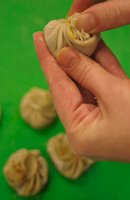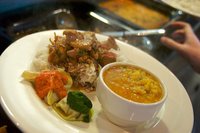Masala and Momo and Ghee, Oh My!
Last Friday, I played hooky from editing and attended a five-hour class in Indian cooking at the Oregon Culinary Institute. What a blast! This was an experience I would recommend to anyone who loves food, whether they think they can cook or not. I came home with my own garam masala--a classic mix of Indian spices--and a dozen recipes.
It was 9am when I met up with my classmates at the sleek little restaurant that is the public face of the school (located at 1701 SW Jefferson Street, at the edge of downtown Portland). Our group included Sarah Bagley, Northwest Palate’s art director, who had never even TASTED Indian food (boy, was she in for a treat), Cameron Nagel, the Palate’s founder and publisher (he’s tasted just about everything), and a few other folks. Inside the restaurant, we were introduced to Brian Wilke, OCI’s executive chef and education director, and we all sipped lattes and espressos as we made our way past the restaurant into a classroom that looked just like any other classroom. There we met our Indian cooking instructor, Bikram Vaidya, who is definitely NOT like any other teacher I’ve ever had.

Bikram, who is actually from Kathmandu, Nepal, has a smile as blinding as snow-capped peak. He quickly drew us a map of India and divided it into elevations, from sub-tropical southern India to the temperate mid-section to the high Himalayas. He described how the seasonal progression of monsoon rains affects every aspect of Indian agriculture, from basmati rice to Darjeeling tea. “Seventy percent of the world’s spices come from India,” he declared. No wonder spices are so prevalent in Indian cooking. (And how strange, on reflection, to think that the English, with their bland palates, were the ones to colonize this most flavorful of realms.)
Our classroom time was short and sweet; Brian and Bikram quickly led our group into a big, clean kitchen where cups of fragrant chai awaited each of us. There we met three of OCI’s professional cooking students, who were there for the express purpose of rescuing us from whatever mischief we might get ourselves into.
But it wasn’t time to cook just yet. Instead we were invited to stick our noses into cups of cinnamon, peppercorns, cloves, coriander seeds, cumin, cardomom, nutmeg, turmeric, asafoetida, fenugreek, ginger--all essential flavors in Indian cuisine. And we all tasted from seven cups of spices that had been blended with water, heated to varying temperatures (heat changes the flavors of many spices), and arranged according to their flavors and aromas, from savory to salty to sour to sweet.
Sarah and I were beginning to eye the row of stovetops somewhat nervously, wondering if their restaurant-level BTUs would set fire to our eyebrows. Anxiety quickly gave way to a feeling of power and usefulness once we all actually turned on the gas. Each with our own frying pan, we toasted our own garam masala, India’s basic toasted spice mix. On Bikram’s command, we added each ingredient one at a time: crushed cinnamon, peppercorns, cloves, coriander seeds, cumin seeds, cardamom pods, bay leaves, and nutmeg.
After four or five minutes over the flame, our potions started to smell heavenly, and we transferred them into nice, heavy mortars, picked up our pestles, and began pounding and grinding the mixtures into a potent, golden-brown powder while Bikram egged us on.
(By the way, Brian told us you can get a good, heavy mortar and pestle at good Asian markets for around $20, much cheaper than the glossy catalogue offerings.)
Brian gave us a quick tutorial in how to chop an onion (which warrants a whole class in itself) and then, at last, it was time for each of us to pick a recipe and start cooking. I opted for momos, which consist of ground pork (or lamb or turkey), laced with scallions and spices and wrapped neatly in a pot sticker (gyoza) wrapper.

I must say, food preparation just doesn’t seem like work when you have a cadre of professional students who have already set up your mise en place. (Ah, here’s the ground-up ginger! Ah, here’s the minced garlic!) Bikram showed me how to brush the gyoza wrappers with water, add a bit of seasoned pork, and pinch the wrappers closed in a lovely pinwheel design. And after I had made about 10 momos (with about 40 left to go), one of the students finished my work for me.
With six or eight different dishes being prepared at once, Bikram turned into a whirling dervish, flying from one stovetop to the next, lifting pot lids and taking little tastes of everything. We’d started cooking around 10am and by 1pm, all of us were ravenous. Washing our hands and leaving behind our dirty knives, bowls, cloths, and cutting boards, we reconvened in the restaurant. Our creations miraculously reappeared in serving bowls and in no time we had all served ourselves.
Such an array of colors and flavors! There was Megan’s chicken masala, Lisa’s dal bukara (a humble lentil stew), Sarah’s aloo gobhi (potatoes and cauliflower, cooked in ghee and masala), Cameron’s mutter paneer (diced paneer cheese in a fragrant tomato sauce with peas), my pork momos (which the OCI cooking elves had taken somewhere out of sight and finished in a steamer), and plenty of cumin-flavored basmati rice.

Brian and Bikram sat down with us and we all picked up our forks. Actually, only we guests picked up our forks. Brian and Bikram picked up their food in their right hands (in south Asia, it’s always the right hand, not the left). Said Brian, “Why not eat with my hands? After we’ve taken so much care with our flavors, even that slight bit of a metallic taste from the fork just doesn’t seem right.” Good point, I thought, and anyway, how many chances do we get to eat with our hands in polite company? I put my fork down and didn’t pick it up again.
Naturally, I liked “my” momos the best, especially with fresh mint chutney. But the dish I’m going to make at home? The mutter paneer, if I can just get my hands on some commercial paneer. If necessary, I’ll make the paneer myself--it’s pretty much the same as a farmer’s cheese.
The biggest surprise: Bikram said that although he loves cooking (Brian and Bikram are old friends, and Brian recruited him to teach at OCI), his first love is mountain climbing. Suddenly his altitude map of India made sense, as did his many references to “levels” of flavors and heat. He’s a guy who strives for the heights!
I would recommend a class with Bikram and Brian to anyone. For the complete roster of OCI’s non-professional cooking classes, visit www.oregonculinaryinstitute.com.

3 Comments:
Such a blast! I'm definitely heading back there for lunch sometime soon... 4 courses for $9? Can't beat it.
Bikrams pretty good....
I want to try too
Post a Comment
<< Home